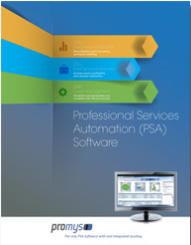
I was recently speaking with a sales person at a prospective customer and he said “I L-O-V-E doing my quotes in Word & Excel. It’s fast, it’s easy, I can cut and paste, change the pricing, format it the way I like, copy previous quotes and get it out the door to customers fast.”
I didn’t say this, but what I was thinking was, “Do you know who doesn’t L-O-V-E your Word & Excel quotes?!? Probably pretty much every other person at your company.
Management only finds out about too low margins after the order get’s booked and can’t get accurate Sales or resource forecasting. Order Fulfillment get’s dirty hand offs from Sales with parts or pricing that’s changed since the 6 month old quote they copied from a previous customer. Service Delivery can’t easily cycle implementation lessons learned back into the quoting process.
Now don’t get me wrong, I’m in sales, I know exactly what that sales person loves about Word & Excel quoting. The complete lack of controls or constraints, standardization and check steps, because that is exactly what makes it ‘fast and easy’ to get a quote out the door to a customer quickly.
What’s Wrong with Spreadsheet-Based Quoting?
The problem is, by saving the sales person five or ten minutes in the quoting phase, it costs the organization hours or days and margin and profitability to sort out issues downstream. Problems such as order fulfillment fire drills to “fix” the bill of materials, wasted technician time on site as tech’s show up with the wrong or incomplete parts, which potentially leads to missed customer deadlines.
These quoting errors all leads to:
- Lower than expected margins
- Dirty hand-offs between sales and order fulfillment based on invalid configurations
- Repeating the same quoting mistakes again and again (definition of insanity)
- Inaccurate sales and resource forecasting
What is the “Better Way” to automate Quoting?
Step #1): Eliminate quoting errors by using quote automation software that links directly to an up-to-date Master Parts List
The problem with spreadsheet-based quoting is that the parts, services and support items in the quote quickly become out-of-date. Items are discontinued, costs change and there’s no easy way for the organization to monitor and check margins before the quote goes to the customer.
The Solution: Use quote automation software that links directly to a master parts list catalogue. This ensures that items on the quote are based on the latest parts and pricing and would allow management to put margin thresholds in place to give the sales person margin discretion to a certain limit, beyond that limit management approval would be required. This would ensure accurate margins and configurations.
Step #2): Stop dirty hand-offs between sales and order fulfillment by linking specific quote versions to specific bills of materials and labor estimates
Another problem with spreadsheet-based quoting is that the detailed Bill of Materials (BOM) and labor estimates are often saved in a separate spreadsheet or document from the quote, and subsequently becomes disconnected from the quoted dollar figures being presented to the customer. This is especially common when the quote goes through 3 or 4 quote revisions. Followed by the dreaded question “Where did these numbers come from ?!?” from the project delivery team as sales hands them a new customer approved quote.
The Solution: Quote automation software would directly link the quoted dollars for product, services and support to the supporting detailed Bill of Materials and labor estimates (which came from the accurate master parts catalogue in the background). The sales person would have formatting options like showing a bulk price, hide model numbers, sub-total, hide items in user defined roll-ups, etc., in order to control the “presentation” of quoting information to the customer. But the parts list and pricing link would be preserved through multiple quote versions so that each quote version would actually be based on its own unique Bill of Materials and labor estimate. This would ensure that no matter which quote version the customer goes with, it’s always based on the correct corresponding Bill of Materials and labor estimate for fulfillment purposes, no matter what presentation format the sales person decided to use for that quote version. This should ensure cleaner hand offs between sales and order fulfillment, resulting in more efficient deployments and happier customers.
Step #3): Stop the insanity, cycle implementation lessons learned back into the quoting process
With spreadsheet-based quoting it’s difficult to cycle implementation lessons learned back into the quoting process because it’s a manual process to compare detailed quoted estimates with detailed project actuals. This can result in significant differences between planned marin and actual margins. The most frustrating part about this is, it may happen again and again without the team being able to recognize patterns and correct the problem to eliminate future quoting mistakes.
The Solution: Quote automation software can pass the materials and labor estimates directly to project management and job costing from a specific quote version. This not only allows project managers to easily compare detailed quoted estimates to detailed project actuals and cycle implementation lessons learned back into the quoting process, it also allows them to get real-time visibility into the cost against estimate/budget performance of their project. This not only allows the organization to significantly reduce under quoting, it also identifies areas where sales people are over quoting, highlighting areas where sales can be even more aggressive on pricing at acceptable margins in order to win more business.
Step #4): Make Sales & Resource forecasting more accurate by linking quote versions directly to sales forecast
The fourth problem with spreadsheet-based quoting, is that it’s very manual and time consuming to roll-up individual sales reps forecasts into one master sales funnel spreadsheet. And because it’s updated manually, it’s immediately out-of-date as soon as the next quote revision or new customer quote goes out. This makes it very hard for management to rely on the sales funnel for accurate revenue, margin and resource forecasting so they can make informed growth investment or resource planning decisions.
The Solution: Quotation automation software can link quotes directly to the sales forecast. That means every time a new quote revision goes out, the sales funnel (revenue, margin, and resources) automatically gets updated in real time. This results in less admin overhead for the sales team, more accurate forecasting information for management decisions, and more planning runway for resource planning. Because the quotes are linked to the sales forecast, quote automation software can slice and dice the forecast by rep by opportunity, by manufacturer, customer, or line of business, which makes the sales forecast even more useful for growth decisions.
Spreadsheet-Based Quoting is Hurting Your Business’ Growth & Profitability
Many sales people love spreadsheet-based quoting because it’s fast, easy and has very few constraints. It’s the rest of the organization that often suffers from the headaches resulting from the lack of visibility or audit trails or controls that are endemic to spreadsheet-based quoting. Those headaches ultimately impact your organizations productivity and profitability.
If this sounds like your organization, it may be time to investigate CRM, Quoting, Help Desk and PSA software that can reduce quoting errors, streamline order fulfillment, stop your organization from repeating past quoting mistakes and get better visibility into an accurate sales funnel.


